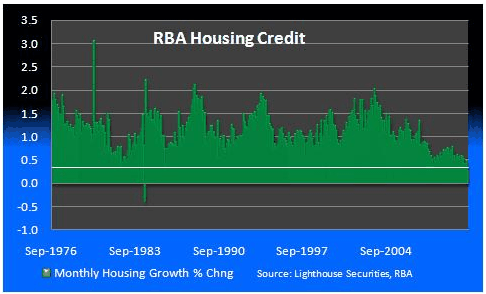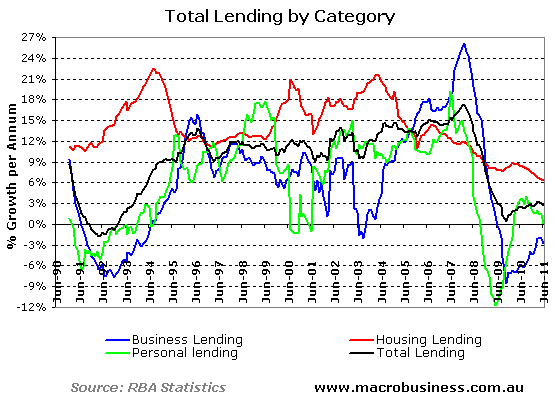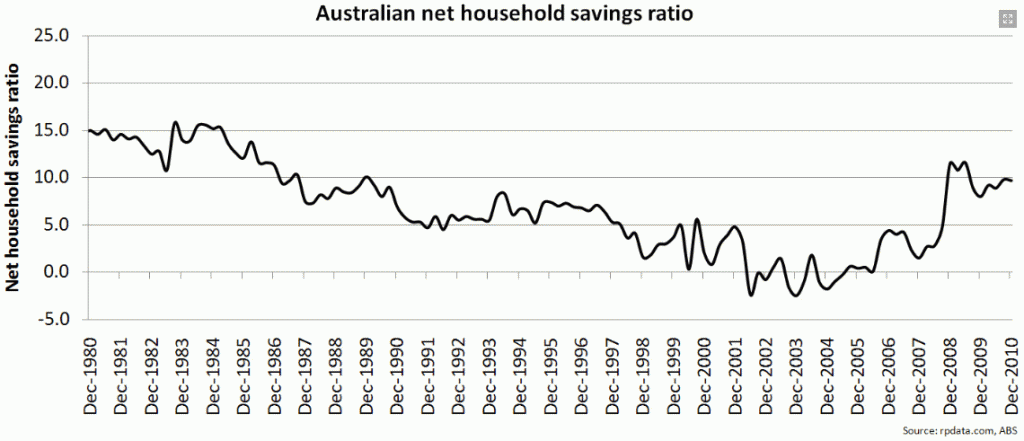
In recent months, the credit ratings agencies – Standard & Poors, Moody’s and Fitch – have warned against the re-emergence of the Australian banks’ pre-GFC business model of borrowing heavily from offshore to pump the Australian housing market.
However, with housing credit growth now at 35 -year lows:

Other categories of lending even more subdued:

And Australia’s household savings rate at multi-decade highs:

The banks have actually reduced their reliance on offshore borrowing and turned instead to funding new lending via deposits.
One by-product of the contraction in credit growth has been the Australian banks’ increasing propensity to compete for market share by lowering credit standards.
For instance, in December last year, Westpac announced that it would accept rental payments as a form of savings for a home deposit in order to widen the target market for the bank’s home loans. Then in March it was reported that Australia’s banks are lifting maximum loan-to-value ratios (LVRs) and are, in some cases, waving mortgage insurance payments on high LVR loans in an effort to increase mortgage lending. And more recently, NAB has slashed mortgage rates via its UBank arm, a move that is apparently a loss-leader for the bank.
Lets not forget that the banks are now offering to pay the exit fees of customers who shift their mortgage from a rival bank, and is some cases are resorting to questionable tactics to stimulate new loan growth (as reported by Delusional Economics here and here).
The banks’ actions are understandable. Since nearly 60% of their total lending is directed toward housing, they are heavily reliant on issuing ever-increasing loan volumes in order to sustain profit growth. At the same time, the security over the banks’ assets (loans) depends heavily on the value of the underlying homes on which they have lent.
Put simply, if Australian households reduce their borrowings, bank profits fall. As such, they are increasingly willing to relax lending standards and offer mortgages to higher risk borrowers in order to sustain both (short-term) profitability and Australia’s over-inflated housing values.
However, it’s a high-risk game that appears to have finally piqued the Australian Prudential Regulatory Authority’s (APRA) interest. As reported in the Australian Financial Review (AFR) yesterday, APRA has sent the banks’ chairmen a letter warning against risky housing lending:
The Australian bank regulator has put bank boards on notice over mortgage lending standards amid signs competition for market share is driving increasingly risky practices.
In a letter addressed to chairmen, the Australian Prudential Regulation Authority reiterated the need the for appropriate a mortgage pricing, adequate loan-to-valuation ratios, loan serviceability and other risk criteria.
“In effect, APRA is asking boards are they satisfied with the credit standards in their bank,” one bank source said. “It’s certainly got a few risk officers going with board reviews.”
APRA is concerned the lower overall growth in mortgage lending has led to instances of overly aggressive competition and is not happy some lenders have “only” eased standards to what they were before the global financial crisis.
“When they hear language [from the banks] like ‘we tightened up lending standards during the GFC and we are just going back to normal’, that gets [APRA’s] attention, said one industry executive.
Another risk officer familiar with the regulator’s position said: “The point is, we are in a different world compared to 2007. That’s [APRA’s] view, so normal is different”…
Some of the “old practices” APRA has flagged include LVRs rising to 95%… and a rise in the cut-in point when borrowers are asked to pay for mortgage insurance, making it possible for riskier borrowers to get a loan…
Some factors APRA is considering include how price rises for housing are built into valuation models, loans to first home buyers who may be carrying debt already, and whether the drive for market share is reflected in lower hurdles for potential borrowers…
Clearly, both the ratings agencies and APRA have signalled that they will not tolerate a return by the banks to pre-GFC levels of mortgage lending. And with mortgage credit growth to remain constrained, the prospect of continued house price growth is diminished as is the banks’ ability to continue growing their profits.
Welcome to the new normal.

